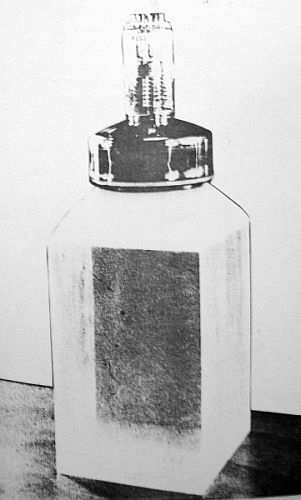Purpose of the flight and payload description
The payload was an omnidirectional large plastic scintillator sensitive to higher energy cosmic rays. The detector system was composed in its central part by a large volume plastic scintillator of parallelepipedical shape measuring 16 x 16 x 24 cm3 coupled through a light pipe to a 13 cm diameter phototube. At left we can see a picture of it.
This detector was sourrounded by a plastic scintillator shielding about 1 cm thick which was used to remove electronically from the spectral analysis the events generated by charges particles that passed throughout both the central and the shielding plastics. The pulses in the external scintillator, commonly called "veto" pulses, were viewed by four 5.1 cm diameter phototubes.
The detector system was transported by a stratospheric balloon, that was launched from Reconquista, Provincia of Santa Fe, Argentina, on February 24, 1992. The energy loss spectra of both the atmospheric gamma-radiation and the charged component of the secondary cosmic radiation were alternatively measured at different altitudes, during the ascent of the balloon, and during the five hours of the flight at ceiling altitude.
Details of the balloon flight
Balloon launched on: 2/24/1992
Launch site: Third Air Brigade, Reconquista, Santa Fe, Argentine
Balloon manufacturer/size/composition: Zero Pressure Balloon
End of flight (L for landing time, W for last contact, otherwise termination time): 2/24/1992
Balloon flight duration (F: time at float only, otherwise total flight time in d:days / h:hours or m:minutes - ): 6 h
External references
- A Determination of the Atmospheric Gamma-Ray Spectrum between 10 and 100 MeV made at High Geomagnetic Cut-Off Revista Mexicana de Astronomia y Astrofisica, Vol. 36, p. 81-88 (2000)
- Response of a Balloon-Borne Omnidirectional Detector to the Atmospheric Secondary Charged Cosmic Radiation at a Place of 11.5 GV Geomagnetic Cut-Off Revista Mexicana de Astronomia y Astrofisica, Vol. 37, pp. 159-164 (2001)
1768If you consider this website interesting or useful, you can help me to keep it up and running with a small donation to cover the operational costs. Just the equivalent of the price of a cup of coffee helps a lot.


